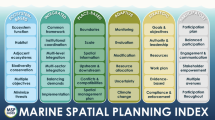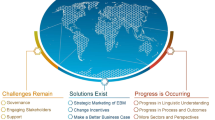Abstract
Sustainable Development Goal (SDG) 14 provides a vision for the world’s oceans; however, the management interventions that are needed to achieve SDG 14 remain less clear. We assessed the potential contributions of seven key area-based management tools (such as fisheries closures) to SDG 14 targets. We conducted a rapid systematic review of 177 studies and an expert opinion survey to identify evidence of the ecological, social and economic outcomes from each type of tool. We used these data to assess the level of confidence in the outcomes delivered by each tool and qualitatively scored how each tool contributes to each target. We demonstrate that a combination of tools with diverse objectives and management approaches will be necessary to achieve all of the SDG 14 targets. We highlight that some tools, including fully and partially protected areas and locally managed marine areas, may make stronger contributions to SDG 14 compared with other tools. We identified gaps in the suitability of these tools to some targets, particularly targets related to pollution and acidification, as well as evidence gaps for social and economic outcomes. Our findings provide operational guidance to support progress toward SDG 14.
This is a preview of subscription content, access via your institution
Access options
Access Nature and 54 other Nature Portfolio journals
Get Nature+, our best-value online-access subscription
$29.99 / 30 days
cancel any time
Subscribe to this journal
Receive 12 digital issues and online access to articles
$119.00 per year
only $9.92 per issue
Buy this article
- Purchase on Springer Link
- Instant access to full article PDF
Prices may be subject to local taxes which are calculated during checkout





Similar content being viewed by others
Data availability
Data supporting the analyses and results of this study are available in the Supplementary Information.
References
United Nations General Assembly Transforming Our World: The 2030 Agenda for Sustainable Development A/RES/70/1 (UN, 2015).
Singh, G. G. et al. A rapid assessment of co-benefits and trade-offs among Sustainable Development Goals. Mar. Policy 93, 223–231 (2018).
Claudet, J. et al. Perspective a roadmap for using the UN decade of ocean science for sustainable development in support of science, policy, and action. One Earth 2, 34–42 (2020).
Ntona, M., Morgera, E. & Ntona, M. Connecting SDG 14 with the other Sustainable Development Goals through marine spatial planning. Mar. Policy https://doi.org/10.1016/j.marpol.2017.06.020 (2017).
Cormier, R. & Elliott, M. SMART marine goals, targets and management—is SDG 14 operational or aspirational, is ‘Life Below Water’ sinking or swimming? Mar. Pollut. Bull. 123, 28–33 (2017).
Preliminary Analysis of Area-Based Management Measures to Support SDG Implementation (UNEP, 2017).
Diz, D. et al. Mainstreaming marine biodiversity into the SDGs: the role of other effective area-based conservation measures (SDG 14.5). Mar. Policy 93, 251–261 (2018).
Haas, B., Fleming, A., Haward, M. & McGee, J. Big fishing: the role of the large-scale commercial fishing industry in achieving Sustainable Development Goal 14. Rev. Fish. Biol. Fish. 8, 161–175 (2019).
Claudet, J., Roussel, S. & Pelletier, D. Spatial management of near shore coastal areas: the use of marine protected areas (MPAS) in a fisheries management context. Vie Milieu 56, 301–305 (2006).
Ehler, C. & Douvere, F. Marine Spatial Planning: A Step-by-Step Approach Toward Ecosystem-Based Management IOC Manual IOC/2009/MG/53 (UNESCO IOC, 2009).
Jupiter, S. D., Cohen, P. J., Weeks, R., Tawake, A. & Govan, H. Locally-managed marine areas: multiple objectives and diverse strategies. Pac. Conserv. Biol. 20, 165–179 (2014).
Sterling, E. et al. Culturally grounded indicators of resilience in social-ecological systems. Environ. Soc. 8, 63–95 (2017).
Palmer, M. C. & Demarest, C. Getting to good enough: performance of a suite of methods for spatially allocating fishing effort to management areas. Fish. Res. 204, 26–32 (2018).
Agardy, T., di Sciara, G. N. & Christie, P. Mind the gap: addressing the shortcomings of marine protected areas through large scale marine spatial planning. Mar. Policy 35, 226–232 (2011).
Frazão Santos, C. et al. Integrating climate change in ocean planning. Nat. Sustain. https://doi.org/10.1038/s41893-020-0513-x (2020).
Molenaar, E. J. Area-Based Management Tools. In Intersessional Workshops on the Conservation and Sustainable Use of Marine Biodiversity Beyond Areas of National Jurisdiction (Oceans and Law of the Sea division, United Nations, 2013); https://go.nature.com/3m5jylf
Johnson, D., Adelaide Ferreira, M. & Kenchington, E. Climate change is likely to severely limit the effectiveness of deep-sea ABMTs in the North Atlantic. Mar. Policy 87, 111–122 (2018).
Secretariat of the Convention on Biological Diversity, Food and Agriculture Organisation of the United Nations, The World Bank, United Nations Environment Programme & United Nations Development Programme Biodiversity and the 2030 Agenda for Sustainable Development Biodiversity Is Essential for Sustainable Development (UNEP, 2016).
De Santo, E. M. Implementation challenges of area-based management tools (ABMTs) for biodiversity beyond national jurisdiction (BBNJ). Mar. Policy 97, 34–43 (2018).
IPBES IPBES Guide on the Production of Assessments (Secretariat of the Intergovernmental Science-Policy Platform on Biodiversity and Ecosystem Services, 2018).
Sciberras, M. et al. Evaluating the relative conservation value of fully and partially protected marine areas. Fish Fish. 16, 58–77 (2015).
Burke, L., Reytar, K., Spalding, M. & Perry, A. Reefs at Risk Revisited (World Resources Institute, 2011).
Island Voices Global Choices In-Depth Analysis of Partnerships for Small Island Developing States (UN, 2018).
Govan, H. Status and Potential of Locally-Managed Marine Areas in the Pacific Island Region: Meeting Nature Conservation And Sustainable Livelihood Targets Through Wide-Spread Implementation of LMMAs (SPREP/WWF/WorldFish-Reefbase/CRISP, 2009).
Giakoumi, S. et al. Ecological effects of full and partial protection in the crowded Mediterranean Sea: a regional meta-analysis. Sci. Rep. 7, 8940 (2017).
Organization for Economic Co-operation and Development Marine Protected Areas: Economics, Management and Effective Policy Mixes (OECD Publishing, 2017); https://doi.org/10.1787/9789264276208-en
Rochette, J. et al. Delivering the Aichi target 11: challenges and opportunities for marine areas beyond national jurisdiction. Aquat. Conserv. 24, 31–43 (2014).
Roberts, J., Chircop, A. & Prior, S. Area-based management on the high seas: possible application of the IMO’s particularly sensitive sea area concept. Int. J. Mar. Coast. Law 25, 483–522 (2010).
Warner, R. M. Conserving marine biodiversity in areas beyond national jurisdiction: co-evolution and interaction with the law of the sea. Front. Mar. Sci. 1, 6 (2014).
Gjerde, K. M. et al. Protecting Earth’s last conservation frontier: scientific, management and legal priorities for MPAs beyond national boundaries. Aquat. Conserv. 26, 45–60 (2016).
Special Areas Under MARPOL (IMO, 2020).
Stafford, R. & Jones, P. J. S. Viewpoint—ocean plastic pollution: a convenient but distracting truth? Mar. Policy 103, 187–191 (2019).
Blythe, J. et al. The dark side of transformation: latent risks in contemporary sustainability discourse. Antipode 50, 1206–1223 (2018).
Geels, F. W., Sovacool, B., Schwanen, T. & Sorrell, S. Sociotechnical transitions for deep decarbonization: accelerating innovation is as important as climate policy. Science 357, 1242–1244 (2017).
Department of Economic and Social Affairs The Sustainable Development Goals Report 2019 (UN, 2019).
Pittman, J. & Armitage, D. Governance across the land-sea interface: a systematic review. Environ. Sci. Policy 64, 9–17 (2016).
Delevaux, J. M. S. et al. A linked land-sea modeling framework to inform ridge-to-reef management in high oceanic islands. PLoS ONE 13, e0193230 (2018).
Recuero Virto, L. A preliminary assessment of the indicators for Sustainable Development Goal (SDG) 14 “Conserve and sustainably use the oceans, seas and marine resources for sustainable development”. Mar. Policy 98, 47–57 (2018).
Ban, N. C. et al. Well-being outcomes of marine protected areas. Nat. Sustain. 2, 524–532 (2019).
Bennett, N. J. & Dearden, P. Why local people do not support conservation: community perceptions of marine protected area livelihood impacts, governance and management in Thailand. Mar. Policy 44, 107–116 (2014).
Devillers, R. et al. Reinventing residual reserves in the sea: are we favouring ease of establishment over need for protection? Aquat. Conserv. 25, 480–504 (2015).
Gill, D. A. et al. Capacity shortfalls hinder the performance of marine protected areas globally. Nature 543, 665–669 (2017).
Álvarez-Romero, J. G. et al. Integrated cross-realm planning: a decision-makers’ perspective. Biol. Conserv. 191, 799–808 (2015).
Reuter, K. E., Juhn, D. & Grantham, H. S. Integrated land-sea management: recommendations for planning, implementation and management. Environ. Conserv. 43, 181–198 (2016).
Zupan, M. et al. Marine partially protected areas: drivers of ecological effectiveness. Front. Ecol. Environ. 16, 381–387 (2018).
Rocliffe, S., Peabody, S., Samoilys, M. & Hawkins, J. P. Towards a network of locally managed marine areas (LMMAs) in the Western Indian Ocean. PLoS ONE 9, e103000 (2014).
Lester, S. E., McDonald, G., Clemence, M., Dougherty, D. T. & Szuwalski, C. S. Impacts of TURFs and marine reserves on fisheries and conservation goals: theory, empirical evidence, and modeling. Bull. Mar. Sci. 93, 173–198 (2017).
Bennett, N. J. & Dearden, P. From measuring outcomes to providing inputs: governance, management, and local development for more effective marine protected areas. Mar. Policy 50, 96–110 (2014).
Biedenweg, K., Stiles, K. & Wellman, K. A holistic framework for identifying human wellbeing indicators for marine policy. Mar. Policy 64, 31–37 (2016).
Kincaid, K., Rose, G. & Devillers, R. How fisher-influenced marine closed areas contribute to ecosystem-based management: a review and performance indicator scorecard. Fish Fish. 18, 860–876 (2017).
Pomeroy, R. S., Parks, J. E. & Watson, L. M. How Is Your MPA Doing? A Guidebook of Natural and Social Indicators for Evaluating Marine Protected Area Management Effectiveness (IUCN, 2004); https://doi.org/10.1016/j.ocecoaman.2005.05.004
Ganann, R., Ciliska, D. & Thomas, H. Expediting systematic reviews: methods and implications of rapid reviews. Implement. Sci. 5, 56 (2010).
Sinclair, S. P. et al. The use, and usefulness, of spatial conservation prioritizations. Conserv. Lett. https://doi.org/10.1111/conl.12459 (2018).
Acknowledgements
We thank N. Ban for her support in this work, including survey development and comments on an earlier version of this manuscript. This work was supported by the Mitacs Globalink Research Award and a Discovery Grant of the Natural Sciences and Engineering Research Council (NSERC) of Canada awarded to R.D.; J.C. was supported by BiodivERsA (METRODIVER) and Agence Nationale de la Recherche (ANR-14-CE03-0001-01). Icons used in Figs. 1 and 3–5 are attributed to Becris (LMMA), Freepik (FPA, PPA), Mavadee (PSSA), Smashicons (FC), Surang (GRA) and Wichai.wi (TURF) from www.flaticon.com.
Author information
Authors and Affiliations
Contributions
All of the authors contributed to the conception of this research, study design and editing the manuscript. J.M.R. reviewed the literature, conducted the expert opinion survey, performed analyses and drafted the manuscript.
Corresponding author
Ethics declarations
Competing interests
The authors declare no competing interests.
Additional information
Publisher’s note Springer Nature remains neutral with regard to jurisdictional claims in published maps and institutional affiliations.
Supplementary information
Supplementary Information
Supplementary Tables 1–6, Figs. 1–4 and references.
Supplementary Data
Supplementary Data, including rapid systematic review data, condensed survey data, confidence assessment and ABMT scoring.
Rights and permissions
About this article
Cite this article
Reimer, J.M., Devillers, R. & Claudet, J. Benefits and gaps in area-based management tools for the ocean Sustainable Development Goal. Nat Sustain 4, 349–357 (2021). https://doi.org/10.1038/s41893-020-00659-2
Received:
Accepted:
Published:
Issue Date:
DOI: https://doi.org/10.1038/s41893-020-00659-2
This article is cited by
-
Towards a global strategy for the conservation of deep-sea active hydrothermal vents
npj Ocean Sustainability (2023)
-
Contribution of area-based fisheries management measures to fisheries sustainability and marine conservation: a global scoping review
Reviews in Fish Biology and Fisheries (2023)
-
SDG 14: life below water- viable oceans necessary for a sustainable planet
Environmental Sustainability (2023)
-
An assessment of requirements in investments, new technologies, and infrastructures to achieve the SDGs
Environmental Sciences Europe (2022)



